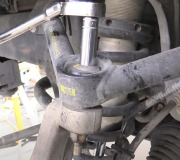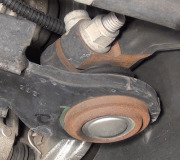Wednesday, January 24th, 2024 AT 1:47 PM
Wheel alignment?
7 Replies
There's "normal specifications for caster and camber, and then there's specifications for Fords. They use uncommon values to achieve the best handling and ride quality with tire wear being less important. As such, I have to rely on those factory specifications. They're in the first image below.
Tire wear takes some time to show up. The other two concerns are whether the vehicle pulls to one side when you let go of the steering wheel, and if the steering wheel is straight when driving on a straight road. If those are okay, the alignment can probably be left alone.
Tire wear takes some time to show up. The other two concerns are whether the vehicle pulls to one side when you let go of the steering wheel, and if the steering wheel is straight when driving on a straight road. If those are okay, the alignment can probably be left alone.
Was this helpful?
Yes
No
Wednesday, January 24th, 2024 AT 2:51 PM
I guess I ran out of time to post my update. Here's the full version of my story:
There's "normal" specifications for caster and camber, and then there's specifications for Fords. They use uncommon values to achieve the best handling and ride quality with tire wear being less important. As such, I have to rely on those factory specifications. They're in the first image below.
Tire wear takes some time to show up. The other two concerns are whether the vehicle pulls to one side when you let go of the steering wheel, and if the steering wheel is straight when driving on a straight road. If those are okay, the alignment can probably be left alone.
So, to answer your question, if your steering wheel is straight and there's no noticeable pull, your vehicle's alignment is probably okay. Check the tire wear two or three times per year. Watch for accelerated smooth camber wear on the inner edges on the front tires, and a little choppy total toe wear on the rear.
There's "normal" specifications for caster and camber, and then there's specifications for Fords. They use uncommon values to achieve the best handling and ride quality with tire wear being less important. As such, I have to rely on those factory specifications. They're in the first image below.
Tire wear takes some time to show up. The other two concerns are whether the vehicle pulls to one side when you let go of the steering wheel, and if the steering wheel is straight when driving on a straight road. If those are okay, the alignment can probably be left alone.
So, to answer your question, if your steering wheel is straight and there's no noticeable pull, your vehicle's alignment is probably okay. Check the tire wear two or three times per year. Watch for accelerated smooth camber wear on the inner edges on the front tires, and a little choppy total toe wear on the rear.
Was this helpful?
Yes
No
Wednesday, January 24th, 2024 AT 5:11 PM
If your steering wheel is straight and there's no noticeable pull, your vehicle's alignment is probably okay. Check the tire wear two or three times per year. Watch for accelerated smooth camber wear on the inner edges on the front tires, and a little choppy total toe wear on the rear.
Was this helpful?
Yes
No
+1
Monday, January 29th, 2024 AT 9:25 AM
Hi guys. Very sorry that I left you hanging. Had a computer hiccup for a few days but it appears to be okay now.
The question here is how hard should the service writer try to sell you an alignment? This isn't a question of "yes" or "no". Rather, it's how much better do you want to make it? The numbers suggest there's plenty of room for improvement, but in my opinion, the money spent would not be a good value. You haven't said yet if there's a pull and whether the steering wheel is straight, so all we have to go on is tire wear. That's up to you to keep an eye on.
The question here is how hard should the service writer try to sell you an alignment? This isn't a question of "yes" or "no". Rather, it's how much better do you want to make it? The numbers suggest there's plenty of room for improvement, but in my opinion, the money spent would not be a good value. You haven't said yet if there's a pull and whether the steering wheel is straight, so all we have to go on is tire wear. That's up to you to keep an eye on.
Was this helpful?
Yes
No
Wednesday, January 31st, 2024 AT 5:19 PM
When you're driving on a straight, flat road, the steering wheel should be straight, not turned to either side. The last step of every alignment is we put the steering wheel perfectly straight and lock it there, then we adjust each front wheel, one at a time, to be steering perfectly straight ahead. Assuming we did a careful job, you will have a straight steering wheel when driving. Months or years later, if something changed or shifted related to the alignment, it will usually cause the steering wheel to be off-center. That is one of the three clues an alignment may be necessary.
This is actually a little more complicated than it would seem. A lot of people are confused between the off-center steering wheel vs one that is turned to one side because you're fighting a pull. If you let go of the steering wheel and the vehicle pulls or drifts toward the ditch, you have to grab the steering wheel and turn it to the left to prevent going into the ditch. That is counteracting a pull. That's not the same as a simple off-center steering wheel. Either condition can be caused by an alignment problem. A pull could also be caused by a tire pull. This is where the numbers on the computer screen tell us what to look for. We identify a tire pull by switching tire locations. For example, if you have a left-hand pull now, then switch the two front tires side to side and then have a pull to the right, it's a tire pull. An alignment won't solve that. Also, since you're rotating the tires regularly, if a pull shows up immediately after the rotation, it is likely caused by one of the tires that was on the back and is now on the front. That's another clue that an alignment won't solve the pull.
The bottom line, as I described previously, is there's three things you can observe to tell when an alignment may be needed. If the vehicle goes straight when you let go of the steering wheel, if the steering wheel is straight when driving on a straight road, and tire wear patterns. Only the tire wear patterns have to be watched for a long time before they show up.
The numbers on your printout suggest the vehicle should pull to the left when you let go of the steering wheel. If that disagrees with what you see when driving, it means your vehicle is rather forgiving of the mismatched camber, then, since both values are in green, it means they're both in specs as far as best tire wear. This is why I said there's always room for improvement, but considering the cost, an alignment is probably not a good value right now. You won't see much improvement for the money spent.
This is actually a little more complicated than it would seem. A lot of people are confused between the off-center steering wheel vs one that is turned to one side because you're fighting a pull. If you let go of the steering wheel and the vehicle pulls or drifts toward the ditch, you have to grab the steering wheel and turn it to the left to prevent going into the ditch. That is counteracting a pull. That's not the same as a simple off-center steering wheel. Either condition can be caused by an alignment problem. A pull could also be caused by a tire pull. This is where the numbers on the computer screen tell us what to look for. We identify a tire pull by switching tire locations. For example, if you have a left-hand pull now, then switch the two front tires side to side and then have a pull to the right, it's a tire pull. An alignment won't solve that. Also, since you're rotating the tires regularly, if a pull shows up immediately after the rotation, it is likely caused by one of the tires that was on the back and is now on the front. That's another clue that an alignment won't solve the pull.
The bottom line, as I described previously, is there's three things you can observe to tell when an alignment may be needed. If the vehicle goes straight when you let go of the steering wheel, if the steering wheel is straight when driving on a straight road, and tire wear patterns. Only the tire wear patterns have to be watched for a long time before they show up.
The numbers on your printout suggest the vehicle should pull to the left when you let go of the steering wheel. If that disagrees with what you see when driving, it means your vehicle is rather forgiving of the mismatched camber, then, since both values are in green, it means they're both in specs as far as best tire wear. This is why I said there's always room for improvement, but considering the cost, an alignment is probably not a good value right now. You won't see much improvement for the money spent.
Was this helpful?
Yes
No
Thursday, February 1st, 2024 AT 5:32 PM





